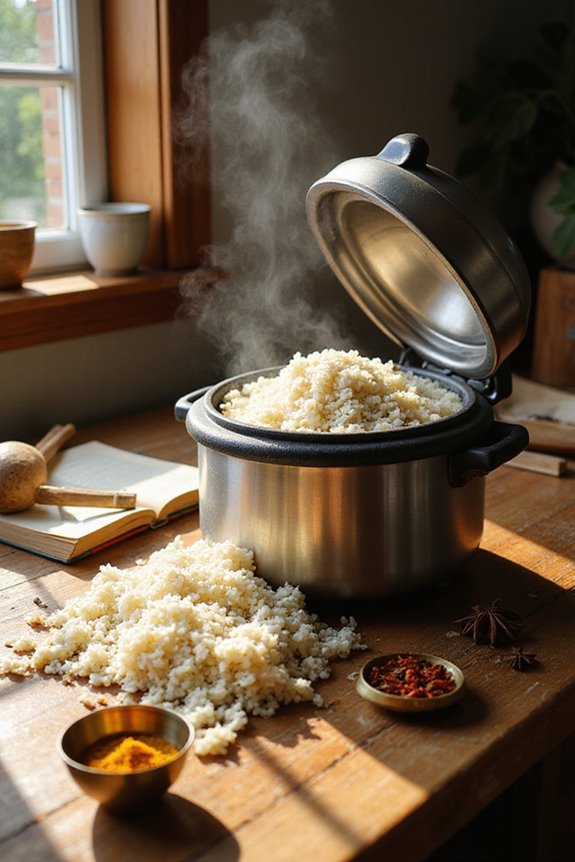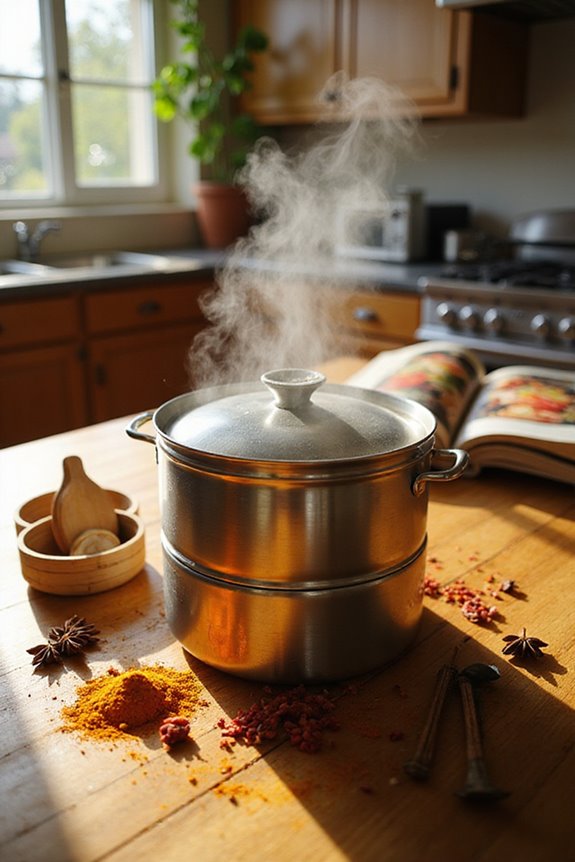If our rice cooker is dishing out mushy rice, let’s uncover the magic behind it! It often happens because of too much water. We need to stick to a 1:1.5 ratio for white rice—1 cup of rice to 1.5 cups of water. Rinsing rice under cold water until it runs clear can also help us avoid the starchy trap. Plus, using the right settings on our cooker makes all the difference. Stay tuned for more tasty tips!
Key Takeaways
- Overcooking rice or using excessive water can cause grains to split and become mushy.
- Old rice may retain moisture, leading to an undesirable texture when cooked.
- Rinsing rice thoroughly before cooking reduces starch and helps keep grains separate.
- Utilizing the correct water-to-rice ratio is crucial for preventing mushiness (e.g., 1:1.5 for white rice).
- Prolonged use of the keep-warm function can negatively affect the rice’s texture.
Common Causes of Mushy Rice
When we immerse ourselves in the delightful world of rice cooking, it can feel like we’re on a holiday adventure, but sometimes things go a little awry—like ending up with mushy rice instead of that fluffy masterpiece we envisioned. Let’s delve into some common causes!
1. Overcooking: Too much time in the cooker can lead to mushiness. Rice types vary, with some absorbing more water.
2. Excess Water: If we add too much water, the grains split and release starch, turning gloppy.
3. Storage Conditions: Old rice can retain moisture, impacting texture. Keep it in a cool, dry place!
Tip: Rinse rice thoroughly before cooking to reduce starch and keep our grains merry and separated! Additionally, choosing a rice cooker with fuzzy logic technology can help automatically adjust cooking times and water levels for optimal results. Happy cooking!
Understanding Water-to-Rice Ratios

Understanding water-to-rice ratios can be a delightful journey into the world of perfect rice cooking! When we measure our ingredients accurately, it’s like celebrating a mini holiday every time we cook. Here are some helpful tips:
- For white rice, we usually stick to a 1:1.5 ratio—1 cup of rice to 1.5 cups of water.
- Brown rice? It needs about 1 cup of brown rice to 1.67 cups of water due to its tough bran layer, which slowpokes water absorption. Additionally, using nonstick rice cookers can help prevent sticking and enhance your cooking experience.
Rinsing and Preparation Techniques

Rinsing rice is one of those magical steps that can transform your cooking experience! It helps us kick out the excess starch that makes our rice mushy and sticky. Here are a few rinsing methods we can try together:
- Cold Water Rinse: Keep it cool to avoid cooking those grains prematurely!
- Strainer or Colander: We’ll use this to wash our rice without losing any precious grains.
- Multiple Rinses: Let’s swirl and rinse 3-4 times until the water runs clear—it’s totally worth it!
- Rice Draining: Remember to drain well after rinsing; it’s essential for a delightful fluffy texture. Additionally, rinsing rice is a step that can help achieve authentic Asian flavors in your final dish, especially when preparing traditional recipes.
Cooking Temperatures and Rice Cooker Settings

Cooking rice can be a true delight, especially when we harness the power of our rice cookers properly! Understanding cooking techniques and temperature management is key. Here are some tips:
- Water Temperature: Always start with cold water. Using water below 30°C prevents that unpleasant odor!
- Cooking Settings: Choose the right settings. For small portions, select “Special Small Amount Cooking” to maintain texture and flavor.
- Keep-Warm Function: It’s fantastic! But don’t let rice sit too long or it may become mushy.
- Advanced Cookers: If you’ve got one, those high-end models with induction heating are your best friend for perfect rice! Additionally, models that incorporate Fuzzy Logic technology can help ensure fluffy rice by adjusting cooking parameters accordingly.
With these strategies, we’ll create rice that’s fluffy, delightful, and a real crowd-pleaser! Happy cooking!
Fixing Mushy Rice After Cooking

If we find ourselves with a batch of mushy rice, don’t panic! We can rescue it through a few delightful drying methods. First, spread the rice thinly on a plate and refrigerate for 20 minutes to a few hours. If we prefer some oven magic, bake it at 325-350°F, checking every 5-10 minutes until fluffy.
Using a Fuzzy Logic rice cooker can help prevent mushiness in the future by automatically adjusting cooking time and temperature based on moisture content. If all else fails, let’s get creative! We can turn that mushy rice into a fantastic rice pudding. Just stir in some cream, sugar, and cinnamon, and voilà— a delicious dessert!
Remember to fluff our fixed rice gently. A fork works wonders! With these easy techniques, we’ll enjoy our rice again, bringing warmth to every meal!
Prevention Tips and Best Practices
Now that we’ve mastered the art of fixing mushy rice, let’s guarantee it doesn’t happen again! To achieve delightful rice results, we need to pay attention to a few key points:
- Rice-to-Water Ratio: Stick to a 1:1 ratio for most rice varieties. This prevents extra moisture from making our dish mushy.
- Rinse Rice: Let’s rinse under cold water until it runs clear. This removes pesky surface starch!
- Cooking Settings: Always use the right setting for each rice type. Remember, patience is a virtue; don’t lift that lid!
- Maintenance: Keep our rice cooker clean and check the seals regularly.
- Heat Distribution Efficiency: Proper heat distribution ensures even cooking and prevents uneven texture in your rice.
Frequently Asked Questions
Can I Use Leftover Rice in the Rice Cooker Again?
Sure, we can safely use leftover rice in the rice cooker! By focusing on proper leftover storage and effective reheating techniques, we’ll guarantee our rice stays flavorful and enjoyable for our next meal together.
How Does the Age of Rice Affect Cooking Texture?
When we cook, the age of rice matters! Fresh rice tends to be stickier, while old rice offers a firmer texture. Together, we can explore these differences to enhance our favorite dishes and traditions.
Does Rice Type Impact Cooking Time Significantly?
Absolutely, rice varieties can dramatically alter cooking times! We’re all in this together when steering through various cooking methods, understanding that each type requires its own unique approach for the perfect fluffy result we all crave.
Can High-Altitude Cooking Change Rice Cooking Methods?
Absolutely, altitude adjustments can greatly change our cooking techniques for rice. We need to account for longer cooking times and increased water to guarantee that our rice turns out perfectly fluffy, not mushy.
Is It Safe to Eat Mushy Rice?
We all know that mushy rice can be tempting, but let’s remember—cooking safety matters too. If handled properly, it’s usually safe to eat. Just be mindful of cooling and storage practices to avoid any risks!





